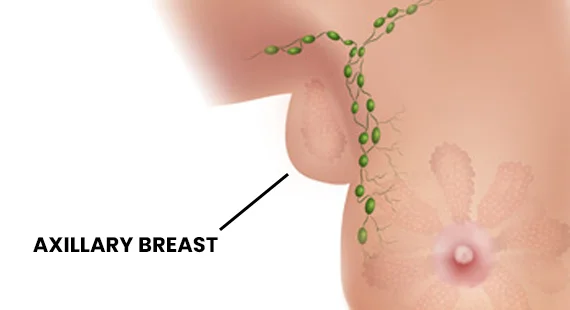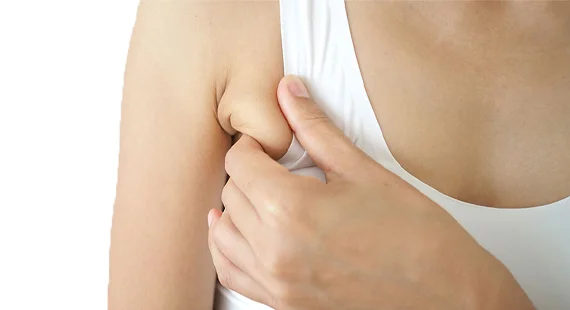Axillary Breast- Symptoms, Causes, Treatment & Cost
The axillary breast is an extra mass of tissue, particularly located in the armpit area or chest wall. It is a common condition that causes cosmetic problems and discomfort. They are evident only after puberty. It can be treated either using open excision surgery or liposuction. It is diagnosed using ultrasound, mammogram, needle biopsy, and MRI (magnetic resonance imaging).

WHAT IS AN AXILLARY BREAST
Axillary breast, also known as accessory breast or polymastia, is a condition in which additional breast tissue develops in the axilla (armpit) area. The exact cause of axillary breast formation is not fully understood, but it is thought to be related to embryonic development.
Axillary breast tissue is usually benign and does not pose any health risks, although it can be a source of cosmetic concern for some individuals. In some cases, axillary breast tissue may become enlarged, painful, or infected, requiring medical attention.

CAUSES
- Genetic factors
- Obesity
- Hormonal changes
HOW IS IT FORMED
An axillary breast may be formed in the womb during fetal development when an extra tissue does not disintegrate, leading to the formation of the axillary breast. During embryonic development, the breast tissue develops along two milk lines that extend from the armpit to the groin. In most cases, the breast tissue along these milk lines regresses, leaving only the breast tissue in the chest area to fully develop. However, in some cases, the breast tissue in the axilla area may persist and continue to develop, leading to the formation of an axillary breast.
Axillary breast formation may also be influenced by hormonal changes, such as those that occur during puberty, pregnancy, or lactation. These changes can cause the existing breast tissue to enlarge, and may also stimulate the growth of additional breast tissue in the axillary area.

SYMPTOMS
- Inability to make appropriate arm postures
- Restricted shoulder movement
- Problem with wearing clothes
- Pain in the arm
- Excessive sweating
- Itching
- Lump pain

DIAGNOSIS
Ultrasound
Mammogram
Needle biopsy
MRI (Magnetic Resonance Imaging)
DO's
DONT's
TREATMENTS
NON SURGICAL TREATMENTS

There are several non-surgical treatments for axillary breast, although these treatments may not be effective for all cases.
Compression garments: Compression garments, such as sports bras or compression vests, can help to compress the axillary breast tissue and reduce its size and prominence.
Laser therapy: Laser therapy can be used to target and reduce the size of the axillary breast tissue, although it may require multiple sessions and its effectiveness may vary.
Cool Sculpting: The non-surgical technique removes the fat from the armpits by freezing the fat cells of the axillary breast.
SURGICAL TREATMENTS

Surgical treatment options for axillary breast tissue include:
- Liposuction: This involves making a small incision and using a suction device to remove the excess fat tissue.
- Excision: This involves making an incision and surgically removing the excess breast tissue. This technique may be used for larger or denser axillary breast tissue.
- Breast reduction surgery: In some cases, axillary breast tissue may be part of a larger breast size issue. Breast reduction surgery can address both the axillary and breast tissue, creating a more proportionate breast size.
RISKS AND COMPLICATIONS
- Bleeding
- Scarring
- Infection
- Stiff shoulder
- Swelling in arm
- Fluid accumulation

IF LEFT UNTREATED
They can lead to extreme cosmetic problems and anxiety. Pain and restricted arm movement occur as a result of the untreated axillary breast. Rarely, the untreated axillary breast may lead to breast cancer.
COST
The average cost of liposuction to treat axillary breast is ₹58,000 - ₹68,000. The cost varies from the type of surgical procedure, hospital facilities and cities.
Financial Options

INSURANCE COVERAGE
Surgery for axillary breast is a cosmetic procedure that is often not covered under health insurance policies because it is considered an elective surgery. However, some insurance plans may cover the surgery if it is deemed medically necessary due to a hormonal imbalance or other medical conditions that cause tissue enlargement.
If your health insurance plan does not cover surgery for axillary breast tissue, you will need to pay for the procedure out of pocket. The cost of the surgery can vary depending on various factors, such as the surgeon's experience, the type of anesthesia used, the complexity of the surgery, and the geographic location of the facility.

Know more about axillary breast
Axillary breast tissue is usually benign and does not pose any health risks, although it can be a source of cosmetic concern for some individuals. In some cases, axillary breast tissue may become enlarged, painful, or infected, requiring medical attention.
Breast tissue can develop in areas other than the normal breast location. If this occurs Glamyo Health can perform a treatment that helps in eliminating your concerns. Breast tissue is responsible for making up the size and shape of the breast. But they can develop at a different location other than normal breast locations under some circumstances. It is common in areas of the armpits (called the axilla). According to research studies, 2% to 6% of women have axillary breasts.
Glamyo Health provides the best and safest options for axillary breast surgery. Know the best Doctors in Delhi and clinics in Delhi. Looking for effective treatment of Axillary breast Surgery?
Read about the Advanced surgical options available to get rid of axillary breast Permanently. If you have questions on how long it takes to recover from surgery, know the estimated time of Surgery Recovery time. We provide you with our happy patient reviews to know their journey throughout the surgical treatment.
 New Delhi
New Delhi  Bangalore
Bangalore  Mumbai
Mumbai  Hyderabad
Hyderabad  Pune
Pune  Chennai
Chennai 
